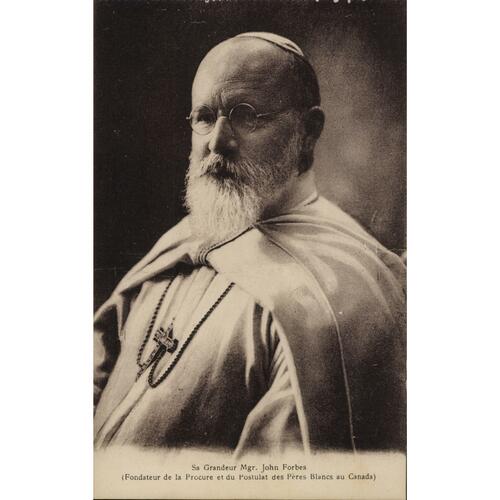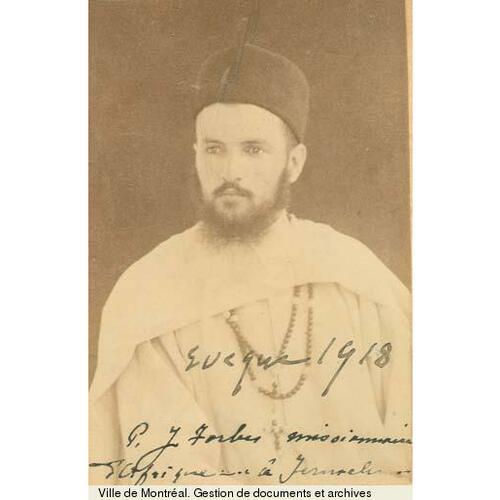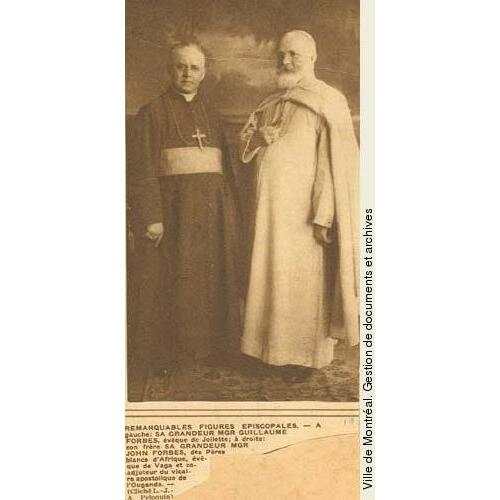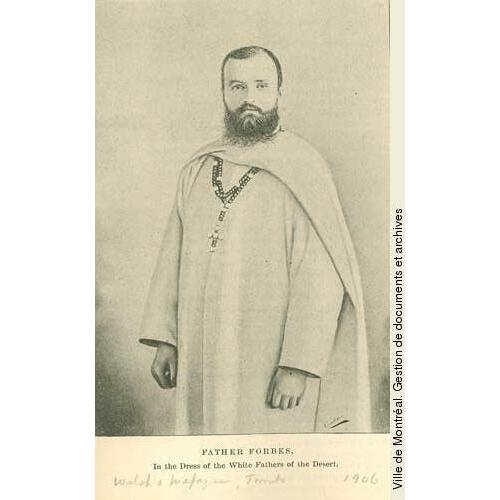FORBES, JOHN (baptized Jean-Paul-Antoine), priest, White Father, and bishop; b. 10 Jan. 1864 on Île Perrot, Lower Canada, son of John Forbes, a farmer, and Octavie Léger; d. 13 March 1926 in Billère, near Pau, France.
John Forbes came from a family of Scottish descent that had become integrated by language and religion into the French Canadian population through intermarriage. The name John, used by his family and friends from early childhood and by himself all his life, recalled his ancestral roots. His parents moved to Montreal in April 1869. The eldest of 16 children, John received a deeply religious education. In September 1870 he and his younger brother Guillaume* were enrolled in the kindergarten run in the Asile Nazareth by the Sisters of Charity of the Hôpital Général of Montreal. From 1872 to 1878, thanks to their maternal uncle Odilon Léger, a well-to-do merchant who took an interest in their education, John and Guillaume attended the Catholic Commercial Academy of Montreal, which was headed by the famous pedagogue Urgel-Eugène Archambeault*. They were both considered brilliant, well-behaved, and devout students. The Sulpicians, who were the chaplains of their school and the pastors of their parish of Notre-Dame, guided them gently towards the priesthood, making them their altar boys at mass and giving them Latin lessons in the presbytery. In September 1878 they accepted the boys into the third year (Method) at the Petit Séminaire de Montréal. Both brothers donned the cassock on 13 May 1883 while completing their final year (the second of the Philosophy program), and they finished their theological studies in 1886. It was now time for the crucial decisions that would transform their dreams into reality. In the fall of 1881 John had read the story of two martyred Catholic missionaries in Urundi (Burundi), in Africa, and it had kindled in him a desire to devote his life to missionary work among Africans. In 1883 he had met a White Father who had come to Montreal to promote the charitable work of the Society of Missionaries of Africa, a congregation founded in 1868 by Archbishop Charles-Martial Lavigerie of Algiers. This meeting had so fired his enthusiasm that he wanted to leave for Africa at once, but the Sulpicians had counselled him to let his missionary commitment ripen. Time had reinforced his decision and on 12 Aug. 1886, through the financial help of Sulpician Jean-Amable Trémolet, he set sail for Africa. His brother Guillaume would opt for the secular clergy and become bishop of Joliette and later archbishop of Ottawa.
On 3 Sept. 1886 Forbes reached Maison-Carrée, the mother house and noviciate of the White Fathers, which was not far from Algiers. He donned the habit on 22 September and gradually, by making the rules and spirituality of the community his own, he became Father Forbes. In his spare time he studied music and Arabic. In 1887 he did another year of theology at the Séminaire Saint-Louis in Carthage, near Tunis, where he took his vow as a missionary on 25 Sept. 1888 and was ordained on 6 October. His dream was to leave for a mission field, but his superiors assigned him to a teaching position. He was sent to Jerusalem, where he was supervisor of studies at the Séminaire Sainte-Anne, known as the Collège Français, from October 1888 to September 1889, and then professor of French and Greek as well as spiritual director until September 1893. This missionary school trained clergy of the Eastern rite to serve various communities of indigenous Christians who were still in communion with the Roman Catholic Church. Recalled to the mother house, Forbes was assistant director of the noviciate, professor of Arabic and Kiswahili, and spiritual director until the summer of 1900. Two important events occurred during his stay there. In January 1894 he went to London with his superior, Mgr Léon Livinhac, to inform Lord Rosebery and Herbert Alfred Cardinal Vaughan about the religious situation in Uganda, where the activities of the Imperial British East Africa Company, which had been charged with developing the territories that were under the authority of a British protectorate, had poisoned relations between Catholics and Protestants. (In March 1898 the British government would pay £10,000 sterling to the equatorial missions as compensation for damage caused by Protestants.) From September 1895 to September 1896 Forbes toured Canada to solicit donations from Catholics, stir their missionary spirit, and recruit future missionaries. This tour would pave the way for a house to be opened in Canada for the White Fathers.
In the summer of 1900 the time was ripe. The episcopate, the Sulpicians, and many spiritual leaders felt that there was not enough missionary zeal in North America, especially among seminarians. At the urging of Sulpician Charles Lecoq, the White Fathers assigned Forbes the task of setting up an institution for postulants or a missionary school in Canada. Despite his keen desire to work in the African missions, he deferred to the will of his superiors and arrived in Montreal on 2 July 1900, but Archbishop Paul Bruchési*, whose archdiocese was already overburdened with charitable endeavours, expressed reservations. Forbes had more success at Quebec. On 11 March 1901 Archbishop Louis-Nazaire Bégin officially authorized him to open a centre there for study and recruitment, adding, however, that he could not give the White Fathers any financial support. That would not stop the project. Since his return from Africa, Forbes had been able to raise enough funds by preaching and lecturing in Canada and the United States, and by other means, to get it set up. On 10 Aug. 1901 he moved into a building he had rented at 41 Rue des Remparts, near the Université Laval, where the students would take courses in theology. He was soon joined by two White Fathers from Africa and on 28 August he welcomed his first six recruits from the province of Quebec. On 8 September, Archbishop Bégin officially blessed the new school for postulants, which moved to a house at 37 Rue des Remparts in May 1902. It was a modest beginning. During the 13 years that he was its superior, six new postulants on average would enrol annually except for the year 1909–10, when there would be none. After a year of training the postulants went to the mother house in Algiers for their noviciate and to Carthage for their scholasticate. To publicize the cause and the work of the White Fathers, Forbes gave many lectures in parishes and seminaries, often using his projector for illustration. In January 1905 he launched at Quebec the monthly magazine Les Missions d’Afrique des Pères blancs, which is still published as Mission. In January 1909 he would add an English edition, African Missions of the White Fathers.
Father Forbes also helped establish a school for postulants of the Sœurs Missionnaires de Notre-Dame d’Afrique, a community founded in 1869 by Cardinal Lavigerie and Marie-Renée Roudaut, named Mother Marie-Salomé. At her request he sought the approval of Archbishop Bégin, who gave his consent for this new foundation after some hesitation. On 26 Oct. 1903 four White Sisters, including a Canadian, Marie Bourque, named Sister Claire, arrived from Algiers and they opened a school for postulants in the building formerly used by the White Fathers. In 1913, as a result of increasing enrolment, they moved to Lévis.
During all his years as superior, Father Forbes had gone back to Africa only once, for a 30-day retreat at the mother house in 1911. He still dreamed of being a missionary in Africa, and it was with great joy that in May 1914 he learned he had been appointed to teach at the high school in Rubaga (Kampala), Uganda. He left Quebec on 4 July, but the outbreak of World War I changed his itinerary. He was sent to replace the superior of the missionary school run by the White Fathers in Bishop’s Waltham, England, where he remained until 15 March 1915. In May he finally reached Rubaga; there he took the official title of superior of St Mary’s School, which had opened in February 1908 to prepare young indigenous Catholics through the study of English and other subjects to assume positions with the government, the army, or large landowners. It had an enrolment of some 160 children in 1915–16. Forbes had been superior of this school for nearly three years when he heard on 18 Feb. 1918 that he had been appointed bishop of Vaga and coadjutor to the vicar apostolic of Uganda, Mgr Heinrich Streicher. He was consecrated bishop on 19 May. The vicariate included Uganda, Ankole, Toro, Bunyoro, and part of the Belgian Congo (Democratic Republic of the Congo), a territory Forbes said was “quite as large in area as [the] great province of Quebec.” Every year he made his pastoral visit, by bicycle until 1921 and thereafter by motorcycle. He spent about ten days at each post, hearing confessions, conducting confirmations, and offering comfort, ever attentive to the spiritual needs and good government of the indigenous population. The education of blacks was a matter of concern for him, and he wanted to have some teaching brothers move in to help the missionaries. For this purpose, as well as to raise money to build a church in Rubaga, which would be his cathedral, he spent the period from March 1922 to December 1923 in Montreal. His efforts would bear fruit. In 1926 four Brothers of Christian Instruction would leave La Prairie for the Uganda missions and, as a result of donations he had collected (more than $100,000, according to his biographer, Abbé Élie-Joseph-Arthur Auclair), the cathedral would be opened for worship that very year.
But Bishop John Forbes would not be present at these happy occasions. Suffering from heart problems, he had to leave Rubaga in February 1925. After spending a few months in Mombasa, Kenya, he went to Paris and then to Billère, where he died of a heart attack on 13 March 1926. He was buried in the cemetery of the White Fathers in Pau. The first Canadian to enter the Society of Missionaries of Africa and the first Canadian bishop from this community, Father Forbes was also one of those heralding the wave of missionary zeal that swept over French Canada beginning in the 1920s.
The Arch. des Pères Blancs in Montreal holds the most materials on John Forbes, in particular his personal correspondence and his annual reports. Forbes is the subject of a detailed biography by Father É.-J.[-A.] Auclair, titled Vie de Mgr John Forbes, le premier père blanc canadien, évêque de Vaga et coadjuteur de l’Ouganda, 1864–1926 ([Québec, 1929]).
ANQ-M, CE601-S50, 10 janv. 1864. Le Devoir, 15 mars 1926. J. F., “Mgr John Forbes, des Pères blancs,” La Semaine religieuse de Montréal, 6 mai 1926. Canada ecclésiastique, 1901–27. Lionel Groulx, Le Canada français missionnaire: une autre grande aventure (Montréal et Paris, 1962). Guy Laperrière, Les congrégations religieuses: de la France au Québec, 1880–1914 (2v. parus, Sainte-Foy, Qué., 1996– ), 2. “Le premier père blanc canadien, son Exc. Mgr John Forbes,” Missions d’Afrique des Pères blancs (Québec), 47 (1951): 261–71.
Cite This Article
Huguette Filteau and Jean Hamelin, “FORBES, JOHN (baptized Jean-Paul-Antoine),” in Dictionary of Canadian Biography, vol. 15, University of Toronto/Université Laval, 2003–, accessed December 24, 2025, https://www.biographi.ca/en/bio/forbes_john_1864_1926_15E.html.
The citation above shows the format for footnotes and endnotes according to the Chicago manual of style (16th edition). Information to be used in other citation formats:
| Permalink: | https://www.biographi.ca/en/bio/forbes_john_1864_1926_15E.html |
| Author of Article: | Huguette Filteau and Jean Hamelin |
| Title of Article: | FORBES, JOHN (baptized Jean-Paul-Antoine) |
| Publication Name: | Dictionary of Canadian Biography, vol. 15 |
| Publisher: | University of Toronto/Université Laval |
| Year of publication: | 2005 |
| Year of revision: | 2005 |
| Access Date: | December 24, 2025 |


![Sa Grandeur Mgr. John Forbes (fondateur de la Procure et du Postulat des pères blancs au Canada) [image fixe] Original title: Sa Grandeur Mgr. John Forbes (fondateur de la Procure et du Postulat des pères blancs au Canada) [image fixe]](/bioimages/w600.7100.jpg)




